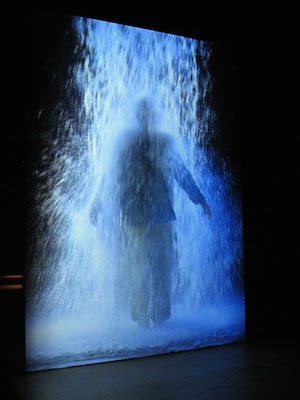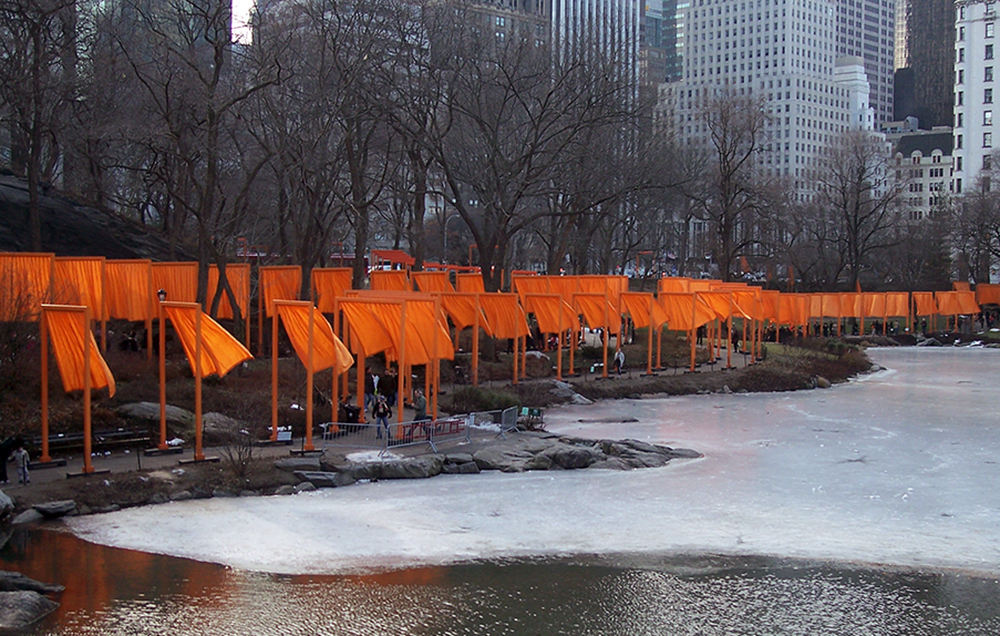10.4 Theories and Interpretations of Global Contemporary Art
2 min read•february 26, 2023
S
Sylvia Rodriguez
S
Sylvia Rodriguez
AP Art History 🖼
34 resourcesSee Units
The Crossing by Bill Viola and The Gates by Christo and Jean-Claude are two iconic works of art that have had a profound impact on viewers around the world. This study guide explores the details of each work, from their symbolism and technical elements to their historical context and reception.
The Crossing by Bill Viola

Bill Viola, The Crossing, 1996, video/sound Bill Viola (photo: stunned, CC BY-NC-SA 2.0)
• A multi-screen video installation that explores the universal themes of life, death and transformation.
• Four large-scale projections of a man and a woman, each one slowly emerging from a pool of water and then walking towards each other.
• Filmed in slow motion, the figures appear to move in a dream-like state and the symbolism of the water evokes the idea of a spiritual baptism or rebirth.
• Accompanied by a powerful score created by Bill Viola himself, the piece creates an emotional experience that encourages viewers to reflect on the cycle of life.
• The installation has been exhibited in numerous museums and galleries around the world, including the Museum of Modern Art in New York, the Hirshhorn Museum in Washington D.C., and the Getty Center in Los Angeles.
The Gates by Christo and Jean-Claude

Christo and Jeanne-Claude, The Gates, 1979-2005 (view across the pond looking southeast) 2005 Christo and Jeanne-Claude
• An environmental installation of 7,503 vinyl gates, each one 16 feet tall and hung with saffron-colored fabric, that was placed along 23 miles of pathways in Central Park in 2005.
• The project was created to celebrate the beauty of the park, as well as to provide a unique experience for viewers who are able to walk through the gates and explore the cityscape from a different perspective.
• The project was funded entirely by Christo and Jean-Claude, who raised the $21 million needed to complete the project through the sale of their own artwork.
• The Gates was on display for two weeks, and was visited by over 4 million people.
• The project was dismantled after two weeks, leaving no trace of its existence except for the memories of those who experienced it.
To conclude, The Crossing by Bill Viola and The Gates by Christo and Jean-Claude are two powerful works of art that have captivated viewers for decades. Through this study guide, we have explored their unique stories and the impact they have had on the art world. Whether experienced in person or through photographs and videos, these works will continue to captivate viewers for generations to come.
Browse Study Guides By Unit
🗿Unit 1 – Global Prehistoric Art, 30,000-500 BCE
🏛Unit 2 – Ancient Mediterranean Art, 3500-300 BCE
⛪️Unit 3 – Early European and Colonial American Art, 200-1750 CE
⚔️Unit 4 – Later European and American Art, 1750-1980 CE
🌽Unit 5 – Indigenous American Art, 1000 BCE-1980 CE
⚱️Unit 6 – African Art, 1100-1980 CE
🕌Unit 7 – West and Central Asian Art, 500 BCE-1980 CE
🛕Unit 8 – South, East, and Southeast Asian Art, 300 BCE-1980 CE
🐚Unit 9: The Pacific, 700–1980 ce
🏢Unit 10 – Global Contemporary Art, 1980 CE to Present
🙏Exam Reviews

© 2025 Fiveable Inc. All rights reserved.